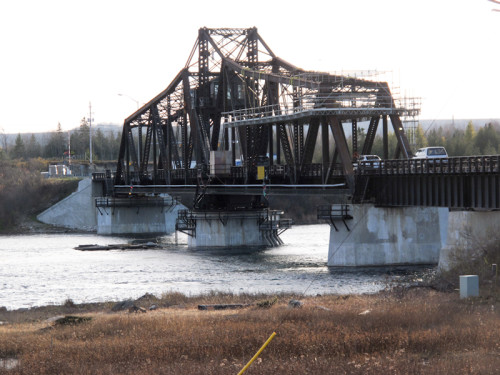Close to $10 million has been spent on refurbishing the swing bridge and the Northeast Town’s municipal council is rallying Island-wide input towards its centennial celebrations next year.
Manitoulin author Bill Caesar has published a lavishly-illustrated history of the bridge, ‘Bridging the Centuries,’ to begin the year-long centennial events and this much-awaited book was launched at a party last week at The Expositor office.
In light of all of this positive energy directed towards the iconic Island landmark, it may not be popular just now to suggest the time is right to be considering an eventual replacement for Manitoulin’s heritage bridge.
We’ve decided to risk the wrath of swing bridge purists, however, and to suggest that as we enter this centennial year of the old bridge’s service, this is precisely the time when we should be considering alternative methods and systems of linking Manitoulin Island to Goat Island via roadway. The bridge, after all and in spite of the millions of dollars lavished on her by the Ontario government, dolling her up and making her fit for her one hundredth birthday party, is still a century-old piece of operating machinery and concrete.
She is also Manitoulin’s sole year-’round link to the outside world and should she fail or be damaged in some way as to render her unfit for traffic to cross, even for a fairly short period of time, the lives of Manitoulin people would be affected in ways not unlike the lives of the people of New Orleans following Hurricane Katrina, only to a far different degree.
But not so different in kind.
Stores and restaurants would quickly run out of food, gasoline stations out of fuel and so on. Land ambulance services would be cut off and many people would not be able to get to or from work.
Temporary fixes would be in place, but not for a few days, and then they would still be only temporary.
This isn’t to suggest that such a situation is by any means imminent. But as bridge historian Bill Caesar pointed out in his remarks at last week’s book launch, the bridging technology that had been the basis for the design and construction of the swing bridge, leading to its inauguration in 1913, had already been outdated since 1910.
Mechanical structures go on and on, of course, but over the nearly past century “the largest fresh water Island in the world” has grown very comfortable with a reliable way of reaching the mainland: initially by train and then by motor vehicle.
Most people, we are certain, would prefer to keep this north-south linkage intact.
So what better time than the bridge’s centennial to celebrate both the past and the future by initiating a meaningful process that would address its eventual succession and to also honour it in this very practical way?



